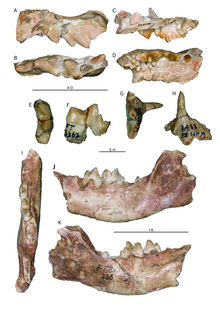Percrocuta is an extinct genus of percrocutid. It lived in Europe, Asia, and Africa, during the Miocene epoch.
| Percrocuta Temporal range:
| |
|---|---|

| |
| Scientific classification | |
| Domain: | Eukaryota |
| Kingdom: | Animalia |
| Phylum: | Chordata |
| Class: | Mammalia |
| Order: | Carnivora |
| Suborder: | Feliformia |
| Family: | Hyaenidae |
| Subfamily: | †Percrocutinae |
| Genus: | †Percrocuta Kretzoi, 1938 |
| Type species | |
| Percrocuta carnifex[3] Pilgrim, 1913
| |
| Species | |
| Synonyms | |
|
Capsatherium Kurtén, 1978 | |
Characteristics
editWith a maximum length of 1.50 m (5 ft), Percrocuta was much bigger than its modern relatives. Like the spotted hyena, it had a robust skull and powerful jaws. Similar to modern hyaenids, its hind legs were shorter than the front legs, resulting in a characteristic sloping back.[4]
Classification
editPercrocuta was introduced as a genus of Hyaenidae in 1938.[3] Percrocuta's relation to the family was debated until 1985, when Percrocuta, Dinocrocuta, Belbus, and Allohyaena were accepted as the four genera of Percrocutidae.[5] More recent evidence, however, has shown that Belbus and Allohyaena at least, are not percrocutids.[6]
Fossil evidence
editP. abessalomi is known only from a skull, two mandibles, and two teeth. These fossils were all collected from the Belomechetskaja, Russia area and date from the sixth Mammal Neogene (MN) zone. This species is the best known of the family Percrocutidae.[citation needed] P. miocenica is known from only a few mandibles, found in Serbia, Bosnia and Herzegovina and Turkey.[7][8] These fossils are also dated to MN 6.[5]
References
edit- ^ Lars Werdelin (2019). "'Middle Miocene Carnivora and Hyaenodonta from Fort Ternan, western Kenya" (PDF). Geodiversitas. 41 (6).
- ^ Xiong, W. (2022). "New species of Percrocuta (Carnivora, Hyaenidae) from the early middle Miocene of Tongxin, China". Historical Biology: An International Journal of Paleobiology: 1–22. doi:10.1080/08912963.2022.2067757. S2CID 248627038.
- ^ a b Kretzoi, M. (1938). "Die Raubtiere von Gombaszög nebst einer Übersicht der Gesamtfauna" (PDF). Annales Musei Nationalis Hungarici. 31: 88–153. Archived (PDF) from the original on 2023-05-06.
- ^ Palmer, D., ed. (1999). The Marshall Illustrated Encyclopedia of Dinosaurs and Prehistoric Animals. London: Marshall Editions. p. 221. ISBN 1-84028-152-9.
- ^ a b Raymond Louis Bernor; Volker Fahlbusch; Hans-Walter Mittmann (1996). The Evolution of Western Eurasian Neogene Mammal Faunas. Columbia University Press. pp. 261–265. ISBN 0-231-08246-0.
- ^ Lars Werdelin; Björn Kürten (1999). "Allohyaena (Mammalia: Carnivora): giant hyaenid from the Late Miocene of Hungary". Zoological Journal of the Linnean Society. 126 (3): 319–334. doi:10.1111/j.1096-3642.1999.tb01374.x.
- ^ Bastl, Katharina; Nagel, Doris; Morlo, Michael; Göhlich, Ursula B. (June 2020). "The Carnivora (Mammalia) from the middle Miocene locality of Gračanica (Bugojno Basin, Gornji Vakuf, Bosnia and Herzegovina)". Palaeobiodiversity and Palaeoenvironments. 100 (2): 307–319. doi:10.1007/s12549-018-0353-0. ISSN 1867-1594.
- ^ Radović, Predrag; Mayda, Serdar; Alaburić, Sanja; Marković, Zoran (2021-04-01). "Percrocuta miocenica (Percrocutidae, Carnivora) from the middle Miocene of Brajkovac (Central Serbia)". Geobios. 65: 41–49. doi:10.1016/j.geobios.2021.02.001. ISSN 0016-6995. S2CID 233574168.